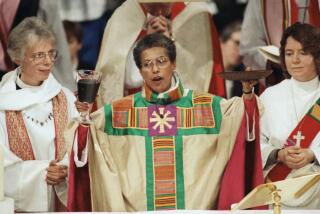Anglicans Clear Way for Naming Women Bishops
CANTERBURY, England — Amid pleas for unity, a gathering of the world’s Anglican bishops Monday effectively took the controversial step of sanctioning the elevation of women as bishops.
By a majority of 423 to 28, with 19 abstentions, the bishops voted in favor of a resolution underscoring the right of the Anglican Communion’s individual geographical provinces to decide for themselves on the divisive issue.
With some of the 28 provinces, including those of the United States and Canada, now on the verge of consecrating their first women bishops, the vote served as a de facto go-ahead for such a development.
However, the size of the majority in favor of the resolution reflected its emphasis on provincial independence rather than any overwhelming enthusiasm for women bishops.
Amended wording noting that respect for a province’s right to ordain a woman bishop was in no way “indicating acceptance of the principle involved” also helped swell the majority.
A second resolution that specifically called on the communion’s provinces to refrain from consecrating a woman bishop in the interest of unity was defeated, but by a much narrower margin of 277 to 187.
Unlike the first vote, this resolution was conducted by secret ballot rather than by a show of hands.
The votes followed one of the most emotive, contentious debates ever witnessed at a Lambeth Conference, the once-a-decade gathering of more than 500 bishops of the Anglican Communion, the world’s second-largest Christian community.
Many have expressed fears that the issue could precipitate a split in the communion.
“There are obviously differences of opinion among us,” Robert A. K. Runcie, the Archbishop of Canterbury, conceded after the vote. “That’s not new.”
Monday’s vote is also likely to complicate unity talks under way with the Roman Catholic and Orthodox churches.
In an attempt to diminish the divisive impact of the move internally, the resolution called for a commission to be appointed by Runcie to monitor relations between provinces and encourage consultation within the Anglican Communion.
Elliptical Wording
The main resolution’s elliptical wording, coupled with the amendment, permitted many of the most ardent opponents of women bishops to vote for it. The tactic appeared to be aimed at preserving at least a facade of unity.
The formula was reminiscent of that employed 10 years ago to avoid similar divisions within the communion on the issue of ordaining women priests.
Since 1978, more than 1,200 Anglican women priests have been ordained in seven provinces, 1,100 of them alone in the United States and Canada. The Church of England, however, has refused to ordain women priests.
Women priests remain controversial and are not permitted to perform the Eucharist in many provinces that have yet to ordain women.
While the ordination of women priests has unsettled the unity of the Anglican Communion, the prospect of women bishops has far deeper implications.
With no central authority, it is the family of bishops that serves as the highest body of the communion. If conservative-minded bishops reject their female counterparts, then a formal schism could result.
Those in favor of women bishops argue that both men and women are equal under God, that the experience with women priests has been overwhelmingly positive and that consecrating woman to the episcopate is merely the next logical step.
“Ordained women are already a feature of our church life,” said the primate of the Episcopal Church of the United States, Edmund L. Browning. “Our people have been blessed by a priestly ministry of ordained women for more than a decade. Therefore, the people of our dioceses move ahead toward calling women to be bishops in a way that is authentic to our experience.”
A Boost From Thatcher
Advocates of the change received an unexpected boost last weekend from Britain’s Prime Minister Margaret Thatcher, who declared she found no conflict between women in the priesthood and Christian doctrine.
Opponents of the move, however, maintained that women bishops constitute a rejection both of the Scriptures and 2,000 years of Christian teaching.
While Runcie praised the spirit of unity at the conference, comments during the debates and after the votes indicated the communion was in for a difficult period.
The Bishop of London, Graham Leonard, one of the most outspoken opponents of women in the episcopate, said he had voted for the main resolution because provincial independence was vital. But he declared that his opposition to women bishops remains as strong as ever.
“I would not be able to be in communion with a woman bishop and those who have consecrated her,” he stated. “The action does raise questions about the very nature of the Gospel.”
Margaret Hewitt, a university lecturer in Britain and leader of a movement within the Anglican Communion against ordaining women, was pessimistic about future unity.
In an interview after the votes, she said the decisions have raised critical questions about the nature of the communion.
“Is there any unity, or is this going to be a sentimental get-together for those in a church with a common history, but no common liturgy or episcopate?” she asked. “Now candid discussions are needed.”
Although rarely expressed directly, opponents of the change conveyed a resentment, believing that North American bishops were insensitive to conservative views and the anguish they would bring to those in less developed provinces.
But advocates of the change were adamant.
Browning, arguing against the resolution calling on provinces to refrain from consecrating a woman bishop, stated: “It misrepresents what women have learned about ministry and what we have learned from these women. It ignores the maturity we have achieved and the gifts we have been given and share.”
More to Read
Sign up for Essential California
The most important California stories and recommendations in your inbox every morning.
You may occasionally receive promotional content from the Los Angeles Times.










